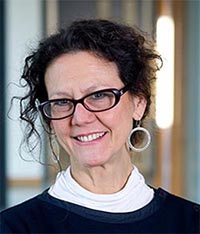Controlling the shape of chiral molecules
Common in nature and found in DNA and amino acids, chiral molecules are asymmetric with a structure that’s different from its mirror image. Chiral amino acids are “left-handed” and cannot be swapped for a “right-handed” equivalent. Why these molecules are lefties is unknown. It’s also unclear how chirality at the molecular scale translates into the much larger meso-scale.

Looking at the chirality of molecules attracted to both water and fats, otherwise known as amphiphiles, a team of Northwestern researchers led by Michael Bedzyk and SQI member Monica Olvera de la Cruz analyzed how to organize the molecules into bigger units. The study showed how different shapes of chiral molecules can be created, which is key information because the utility of chiral molecular assemblies in drug delivery and nanoelectronics is coupled to their overall shape and internal architecture.
“The utility of molecular assemblies for biosensing, drug delivery and nanoelectronics is sensitively connected to the assemblies’ overall shape and internal molecular packing or structure,” Bedzyk said. “This study shows how to attain and control chiral membrane shapes by tuning the solution environment, which should be useful for varied applications based on chiral building blocks.”
Bedzyk, Olvera de la Cruz, and their collaborators presented their work in the paper “Electrostatic Control of Shape Selection and Nanoscale Structure in Chiral Molecular Assemblies,” published August 2 in the journal ACS Central Science. Bedzyk is a professor of Materials Science and Engineering and Physics and Astronomy, and Olvera de la Cruz is the Lawyer Taylor Professor of Materials Science and Engineering, Chemistry, and Chemical and Biological Engineering.

Amphiphiles can assemble in water into a variety of shapes, including micelles used in detergents and bilayer membranes found at the outer wall of biological cells. This process is driven by the hydrophobic end of the amphiphiles wanting to hide from the aqueous solution, while the hydrophilic end is attracted to the aqueous solution. The researchers found that chiral amphiphilic molecules with a charged headgroup can assemble into distinctly shaped membranes, including those with chirality.
“The shape, which can be a flat ribbon, helical ribbon or scroll, can be controlled by tuning the ionic solution environment,” Bedzyk said. “Interestingly, left-handed nanometer-length molecules assemble into a right-handed micron-length helical ribbon or scroll, and vice versa.”
Distinct twisted membrane shapes have been previously generated in disparate molecular systems and experimental conditions. Despite this progress, predicting the membrane shape selection in any given molecular system has remained challenging, causing a knowledge gap that hinders the applicability of these biomolecular systems in practical scenarios.
Carrying out testing at Argonne National Lab’s Advanced Photon Source using small- and wide-angle X-ray scattering, the researchers’ experiments uncovered the structural details on a scale of 0.1 to 100 nm. The investigators’ work was complemented by atomic-force and electron microscopies that helped visualize the shapes of the assemblies along with circular dichroism spectroscopy to confirm the chirality of the membrane assemblies. The dependence of membrane shape on solution conditions was explained by theoretical models.
“This study provides a rational basis for generating a variety of mesoscopic shapes from molecular assembly and for controlling the nano-scale structure of these assemblies,” Bedzyk said.
“This represents a step toward producing simple guidelines or rules for controlling the bilayer structure at multiple length scales,” Olvera de la Cruz said.
The work builds off a 2019 study when researchers showed how to obtain and control the structure of scrolls, taking that forward by displaying how to switch the assembly structure between flat membranes’ helical ribbons and scrolls.
“The overall goal of this project is to generate and explain the complete library of chiral assemblies in a simple charged molecular system,” Bedzyk said.
SQI’s Peptide Synthesis Core Facility provided the peptides used in this study.
This article was first published by Northwestern Engineering.
